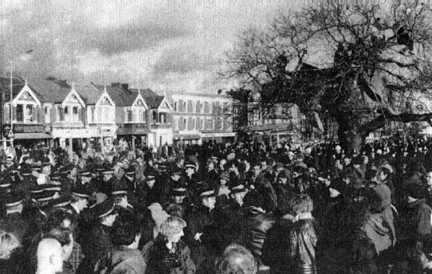
The intention of this guide is to suggest advice on building and maintaining a fluid direct action campaign, by sharing experiences learned from British anti-roads campaigns between 1992 and 1996. It contains ideas on building a campaign, dealing with the accelerating pace as contractors arrive, and practical tactics to stop them. Although we're dealing with roads, much of this is, of course, applicable to building resistance and fighting other types of destructive developments. Information on positive actions, such as "Reclaim the Streets" street parties, is also included.
We won't attempt to duplicate any of the several excellent existing guides on fighting road schemes at an earlier stage. We concentrate on the later stages, involving direct action - although getting in early is vital to win! See Chapter 17 for details of the relevant publications.
Although this guide is based entirely on British experience, and much of its content is specific to Britain, we hope that readers in other parts of the world will find things of interest and use in here as well.
The layout is roughly in the order a campaign might proceed, but as some will probably repeat what you already know, we have also tried to incorporate "dip-into-ability", with easily identifiable subject headings.
Please be aware that this book only represents the opinions of a few people. Direct action requires a questioning attitude and means thinking for yourself. We hope that this will at least be a starting point for ideas; don't stop here! Read and use the lists of contacts and resources in Chapters 16 & 17. In the Appendix we have also included examples of documents from previous campaigns, such as "Beat the Bulldozer" pledges, phone trees, and bust cards.
Good luck, and please keep in touch with any constructive feedback.

The general pattern of British anti-road protests has been separation into a "Lawful Campaigning" phase and a "Direct Action" phase. The stereotypical sequence would be: years of patient, energetic campaigning, lobbying and awareness- raising by dedicated locals; followed by a last-ditch, hectic and spectacular direct action frenzy as construction begins. This is, of course, a very superficial model, and many of those taking part in each phase will be the same people; but it remains true that there is far too much separation, on many levels, between "conventional" campaigning and direct action. One of the main themes of this guide is bridging the gaps.
It's easy to get hung up on definitions of "direct action", "civil disobedience" etc. (see below for a brief discussion). What matters is that the approach at any time should NOT be stereotyped, but should be determined by whatever seems most likely to delay or STOP THE ROAD. It can be surprisingly easy to lose sight of this objective! For example, if you have heard that roads are going to be cut in the Budget, your last £50 may be better spent targetting Treasury officials and MPs, than on buying D-locks. On the other hand, if the contract to build the road has been let, writing indignant letters to the government is a waste of time, that could be better spent building up camp defences, or finishing off the action phone tree.
Deciding what is and isn't appropriate for the campaign will take debate, argument and broad consensus. One of the main benefits of this sort of discussion is that people with different backgrounds can learn from one another, and that direct action tactics can be used in the campaign as and when required, rather than being artificially separate. It's a big mistake to assume that the spontaneity, passion and daring of good direct action should only be used in a limited section of the campaign, or only by a "special" group of activists.
Direct action is powerful and may benefit from careful planning. Consider things carefully and use it appropriately - but don't be afraid to go with your instincts. We'd definitely recommend starting cautiously and "escalating" tactics as time passes and the start of roadbuilding approaches.
This phrase has been applied to a huge variety of activities, and getting on and doing it is much more important than constantly arguing definitions! Briefly, direct action implies acting yourself, in a way that directly addresses the problem which you're confronting, and without relying on, or seeking approval from, politicians, bureaucrats or other mediators. Therefore, if you see bulldozers ripping apart somewhere you care about, you take direct action when you directly intervene to try and stop them.
Direct action also implies rejection of the procedures and rules of the roadbuilders, and having the initiative to decide for yourself what is right and what needs to be resisted, rather than obeying laws or orders. Although direct action can be seen merely as one tool in any campaigner's tool box, it is also much more than this. It means fighting for control of your own life and to attempt directly to affect the world around you, taking responsibility for your actions on your own terms.
In this guide we describe various direct action techniques, as well as ways to support, or build up to, direct action, and also more "conventional" campaigning methods. We don't see this as a hierarchy, but as a diversity without which a campaign will be one-dimensional, and unlikely to stop the road. Do what's right, do what's effective, and JUST DO IT!
The type of protest we will describe is generally called NVDA (Nonviolent Direct Action). It is impossible to adequately discuss the issue of nonviolence here, but a few points are worth making. Most activists would probably agree that British anti-road actions since Twyford Down in 1992 have been mostly nonviolent in character; however, it's important to state that definitions of "nonviolence" vary greatly, and there is a wide range of views. In particular, the right to defend oneself against violence is a controversial point. The people who wrote and edited this themselves differ in opinion on these issues.
Some activists see a nonviolent philosophy as absolutely essential at all times, and would not support any form of action which involved or supported violence; NVDA as both means and ends. Others see NVDA only as a tactic, and believe that violence may sometimes be necessary. It's probably fair to say that the majority of activists agree on nonviolence as the most successful and appropriate approach for fighting roadbuilding in Britain now; that's our view, at least. Therefore, the tactics and ideas outlined in the following pages are nonviolent ones. Ways of dealing with, and reducing, violent behaviour towards yourself are also discussed. (see Chapter 10).
The State has always depended absolutely on threatening and using violence, and will dig deeper into its huge arsenal given any excuses. It will nonetheless be quick to condemn any violence on your side - often including such actions as damage to property. The media will follow this line. It is important to expect this sort of thing and be ready to deal with it. Productive discussion within the campaign about nonviolence needs to happen if the campaign is to cope well with these issues.
It is important to recognise the various stages of roadbuilding to prepare to fight it. After the political decision to build the road has been announced, the first stage will be awarding of the preliminary contracts. (NB. A generalised sequence of a contract award is described in Chapter 7.) The roadbuilding agency will be busy trying to let these contract(s), so now is the time to attempt to sabotage the contracts procedure - see Chapter 10 for ideas.
Around this time, people along the route who have had their properties or land bought under Compulsory Purchase laws will be sent a "Notice to Treat" or similar, giving notice of the earliest date work can start on their property. Get to know these people! Don't use "Notice to Treat" dates as definate, as each only covers a single parcel of land, not the whole route and work can also start well after issue of the Notice.
It is also essential to watch and monitor the route of the road as closely as possible, as this is the time when hostile activity often starts. In particular, look for surveying, vehicles snooping around the route, and sneaky tree-felling (see 'Route Monitoring" in Chapter 8). Because preliminary contracts are usually relatively low in cost and short, it's often hard to discover what's going on with them until the last minute - especially as there may be several. Whilst trying to find out as much as possible from tip-offs, sources in the construction industry etc, the best approach is surely to monitor the route as well as you can, and prepare to stop work if it starts. Now is the time to study, in detail, maps and plans of the road. Preliminary works is the most destructive period, and may include tree-felling, building demolition, drainage, road diversions, earthworks, and some construction; there may also be ecological or archaeological "rescue" contracts.

The main works contract(s) may start soon after the preliminary works, or there may be a delay of months while the contract letting procedures continue. It is a huge advantage if you can find out the start date! When main works do start, it's likely that one of the first jobs of the contractors will be to establish compounds and / or fenced areas of the route. (Of course preliminary works may also have involved some fencing.) Once contractors have thus secured their working space, they'll start getting on with work alarmingly quickly if you let them. The exact order of main works will vary depending on the complexity of the contract. To work out what's going on, remember that everything will be programmed to be completed together, so long jobs like building large flyovers are likely to start relatively early; see the Appendix for an example of a work schedule. Earthmoving is also likely to be started fairly early, especially if there's a lot of stuff to shift; however, it needs to be done between March and October to avoid the worst of the weather. The contractors should inform local residents of the general order of work. The job ends with laying the tarmac, signing and building barriers and roadside fences, tree-planting etc, and finally, the opening ceremony...
Road Alert!
EMAIL: info@roadalert.org.uk